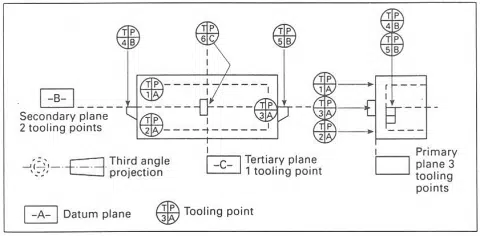
Castings provide a cost effect method to provide the Near Net Shape of a configuration, but critical details are inevitably machined. The machining first cut should always be from the Datum Points of the casting, and just in case something goes wrong, it is important to retain the original casting datums. So it is important that the Casting Datums be located on surfaces that are not subsequently machined. Where the available datum surfaces must be machined, it might sometimes be necessary to create additional features that serve no other purpose than to preserve the Casting Datum Points. If the Casting Datum Points are preserved through subsequent manufacturing, the integrity of the original casting measurements will remain intact.
I also recommend that all Datum Points be co-planer with each other. The basic philosophy of using Datum Points is to establish an arbitrary “Zero Plane” from which to measure. As there is allowable variation between the Zero Plane and other cast features, it is a poor practice to designate features that are not a part of the Zero Plane as also being at “Zero”. Any dimensional variation from nominal, between non-coplanar datum points will skew the measurements of an entire part. I recommend, that if a configuration does not readily offer coplanar datum points, then coplanar features should be added to the configuration such as raised / recessed pads or lugs.
I also recommend that a part should balance on the Primary Datum Points without clamping. Although not always possible, when a part will balance on the Datum Points it helps to prevent any miss-positioning of the casting on the Datum points.
The final point I’d make is to encourage the centering of the datums on the part configuration. Casting variation is cumulative, so the longer the dimension being measured the greater the amount of tolerance should be allowed. Especially when living in the Model Based Definition world, Engineers are being compelled to allow profile tolerances that accommodate the most distant features. Centering the three datums effectively shortens the longest dimensions of the part and lessens that amount of tolerance needed to accommodate the configuration.
I want you to avoid selecting theoretical centerlines as datums as they increase both part and tooling expense while decreasing the accuracy of the part measurements. Datum points need to reside on hard features on the Zero Plane. If there are no hard features, we recommend that you either create them or shift the datum to an adjacent surface.
